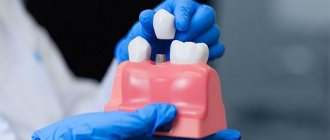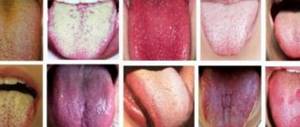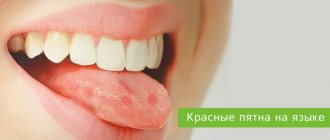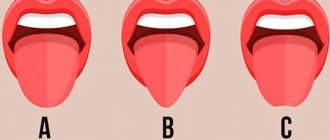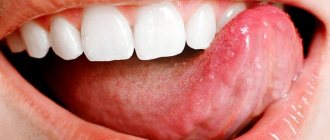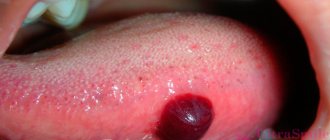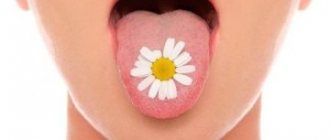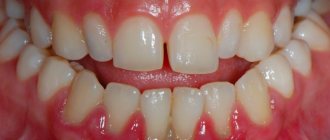Diagnosis of illnesses by language was used by ancient healers. The most famous of them was the great thinker-healer Avicenna. Chinese healers considered the tongue to be a special indicator organ that speaks about the state of the human body as a whole. And if the color of the tongue has changed, then this fact cannot be ignored. We will tell you what a brown coating on the tongue means in this article.
What could a brown coating on the tongue mean: causes, associated symptoms, treatment tactics
Often systemic failures in the body do not manifest themselves at first. It seems to a person that he is completely healthy, but meanwhile the disease continues to progress, gradually becoming chronic. In reality, most ailments signal the beginning of their development, just not so clearly and expressed. One of the possible symptoms may be a coating on the tongue of an atypical color, too dense and difficult to clean. In other cases, this phenomenon does not pose any threat, but is only a consequence of non-pathological conditions, for example, a brown coating on the tongue may appear after drinking coffee or other coloring drinks. Further in this article, we will figure out how to distinguish a real symptom from a non-dangerous physiological phenomenon, what problems a coated tongue indicates, and how to remove dark plaque.
Mechanism of plaque formation
The surface of the tongue is heterogeneous. It is smooth below and covered above with squamous epithelium, papillae and taste buds. Epithelial cells die unevenly. Some of them are washed off at the wrong time and form a plaque. In addition, food particles are retained between the papillae.
They are processed by microbes and bacteria, releasing decay products. Therefore, a plaque forms on the surface. If it is pale gray, white or yellowish, this is normal. You need to be wary when deposits acquire an unnatural color - pronounced yellow, greenish, brown.
However, it is worth remembering that a healthy person without bad habits has a pink tongue with a small amount of coating. The color of the deposits changes only slightly depending on the food and medications consumed. A slight increase in mucus in the intervals between morning and evening brushing of teeth is acceptable.
Plaque of any color other than white signals a malfunction in the functioning of the body. It is extremely rare that it appears due to damage to the organ itself.
How does plaque form on the tongue?
Our main speaking organ is covered by a layer of epithelium, the structure of which varies depending on the location. The lower surface is smooth, while the back has a rough texture with the presence of small papillae, thanks to which we enjoy the taste of our favorite dishes. If a person is completely healthy, his tongue will be pink, with a thin translucent whitish coating.
A healthy tongue is pink with a thin translucent coating
After eating and especially consuming food and drink with intense coloring pigments, the surface of the tongue changes its color. So, for example, coffee and strong tea provoke the formation of a dark brownish plaque, which, however, is easy to remove by simply rinsing your mouth or using a toothbrush and paste. However, if the discharge is quite dense, emits an unpleasant odor, is difficult to remove, and appears again after some time, pathological processes are most likely taking place. In such a situation, experts advise paying close attention to your health. Next, let's find out what a brown coating on the tongue can mean: when it can be easily removed, and when to sound the alarm.
Structure and purpose of the language organ
The tongue is a digestive organ. Essentially, this is a muscle that consists of striated tissue. It is covered with a protective layer - the mucous membrane. The anatomical structure of the organ includes two parts: the body and the root. The upper region is called the back, and under the organ is the frenulum. There are also terminal and longitudinal grooves - the first is located at the junction of the root and the body, and the second divides the organ vertically.
On a note! On the surface of the tongue there are many papillae, which contain taste buds. For example, those responsible for recognizing sweet taste are located on the tip, and salty taste is located on the sides. On the side, closer to the root, there are receptors that react to sour things, but the base of the organ is susceptible to bitter tastes.
The tongue not only allows us to enjoy the taste of our favorite treats, but also takes a very direct part in the conversational function. It also helps us chew food and is responsible for the production of salivary fluid, which, in turn, helps break down food particles and therefore participates in digestion.
When the phenomenon is not associated with pathological processes
When answering the question of why discharge of an uncharacteristic color appears on the tongue, it is first worth understanding the possible non-pathological causes of this phenomenon. Next, we’ll look at why an organ can acquire an atypical color if its health is in perfect order.
Morning plaque that can be detected after sleep
A light yellowish or even brownish coating in the morning after sleep is a natural physiological phenomenon that should not be alarmed. During a night's rest, all processes in the human body slow down, saliva becomes more viscous and does not wash the oral tissues well. This is a good time for bacteria that begin to actively multiply. The products of their vital activity form the basis of morning secretions on the mucous membrane and surface of the teeth. It is enough to carry out standard hygienic cleaning to remove deposits and freshen your breath.
Morning plaque can be easily removed after hygienic procedures
Consequences of long-term exposure to nicotine
Intense yellow or even brown discharge is a fairly common occurrence among heavy smokers. The reason for this is the tars that make up cigarettes. They and other components have pronounced coloring properties, which over time leads to yellowing of not only the teeth and mucous membranes, but even the fingertips with which the smoker holds a cigarette.
Plaque is caused by smoking
In addition, tobacco smoke in general negatively affects the condition of the tissues of the oral cavity - the mucous membrane weakens, loses density and elasticity, becomes irritated and inflamed, and the teeth become covered with a yellow coating, are gradually destroyed and are subject to aggressive carious processes.
The result of drinking coffee or strong tea
As mentioned above, drinking coffee and strong tea can also lead to a change in the color of the mucosal epithelium. This also includes many berries with intense coloring pigments, chocolate, red wine, and sweet drinks. To remove pigmentation in this case, just thoroughly brush your teeth and the back of your tongue with a brush and toothpaste.
Frequent consumption of tea and coffee can stain your teeth and tongue
Consequence of taking antibiotics or other powerful medications
Long-term drug therapy with certain antibiotics and potent drugs can also lead to the appearance of this symptom. So, for example, a dark brown coating often appears after taking the drug Faringosept, a drug that is often prescribed for the treatment of ENT diseases. Manufacturers usually indicate this side effect in the instructions. The deposits disappear after stopping taking antibiotics or other medications that cause a similar side effect.
A drug such as Faringosept turns the tongue brown
In what cases does a brown tongue indicate health problems?
If the consistency of the deposits is quite dense, it is impossible to completely remove them with a brush or the discharge will soon form again, if bad breath and other accompanying symptoms appear, it is probably all about the development of pathological processes. Brown color usually signals a malfunction of the gastrointestinal tract, but there are other possible reasons for this phenomenon.
Diseases of the oral mucosa
If we talk about dental prerequisites, then brown plaque often means the development of fungal diseases - oral candidiasis. At first, dense discharge of a whitish or yellowish color forms, but if you ignore the problem for a long time, they can noticeably darken and acquire a brown tint. The appearance of dark spots on the tongue may also indicate the development of stomatitis. If the white plaque has darkened, this means that the pathological process is rapidly progressing, and the patient needs urgent medical attention.
If left untreated, a fungal infection may become noticeably darker.
Sometimes the cause is inflammation of the epithelium of the organ - glossitis. Along with brown discharge, erosion or ulcers occur. The development of pathology is accompanied by the appearance of painful sensations and severe swelling of the organ.
Pathologies of the gastrointestinal tract
As noted above, the most common cause is malfunction of the stomach and digestive tract. According to experts in the field of gastroenterology, such a symptom usually indicates the development of one of the following pathologies:
- gastritis, stomach or duodenal ulcer,
- dysbacteriosis,
- Crohn's disease or granulomatous enteritis,
- duodenitis or chronic inflammation of the duodenum,
- obstruction of the bile ducts.
Diseases of the gastrointestinal tract can cause such a symptom.
A change in the color of the surface of the tongue towards a yellow or brownish tint may also indicate severe dehydration of the body. In any case, if the plaque cannot be completely removed or it reappears too quickly, you should consult a doctor.
Systemic disorders
A symptom may be a signal that some disturbances are occurring in the body, both minor and serious. Brown spots sometimes indicate an acute deficiency of B vitamins, the development of pellagra, Addison's disease, and diabetic coma. Such conditions can lead to very serious and even disastrous consequences, so under no circumstances should you delay diagnosis and start treatment.
Liver diseases can be classified as a separate category. The main danger is that most of these ailments are completely asymptomatic at first. The reason may be minor biliary dyskinesia, cholecystitis, bending of the gallbladder, cholelithiasis, as well as serious pathologies such as hepatitis, cirrhosis or oncology. Therefore, when changing the color of an organ, it is worth paying close attention to the accompanying manifestations, which may not be expressed too clearly:
- yellowing of the skin and whites of the eyes,
- bitterness in the mouth,
- pain under the ribs on the right side,
- nausea after eating,
- weakness, fatigue,
- skin itching.
Liver disease causes a bitter taste in the mouth and darkening of the tongue.
A diagnosis related to the condition of the liver can only be made by a qualified doctor after carrying out the necessary diagnostic procedures. Self-medication is strictly contraindicated.
Other possible causes of darkening of the back of the tongue, experts include diseases of the respiratory system, malfunctions of the lymphatic system, arthritis and arthrosis. In a child, a similar symptom may indicate a helminthic infestation, and in women during pregnancy or after menopause, it may indicate changes in hormonal levels.
Fact No. 2: brown color is one of the signs of problems with internal organs
A brown coating on the tongue in adults or children has different causes, but almost always indicates that at least one of your internal organs has become infected. And, with a greater degree of probability, of all possible cases, the problem is localized in the intestines or stomach1.
Important!
The surface of the tongue is covered with microscopic papillae, which are actively involved in determining various taste sensations.
On top, the papillae are protected by a thin epithelium, which, with good immunity, constantly dies and is renewed. If disturbances are detected in the body, the epithelium becomes denser and ceases to renew itself. And given that the smallest particles of food and plaque periodically settle on it, the mucous membrane becomes the best and most convenient environment for the proliferation of bacteria. The tongue is a kind of mirror of the body. It can consider even the earliest and first signs of infectious and non-infectious diseases. It is also a muscular organ and a kind of receptor that transmits signals to other organs, in particular to the digestive tract, as a result of which metabolic processes are launched in it and enzymes are produced. If the stomach or intestines are sick, then the exact opposite reaction occurs, nerve signals go from them to our tongue. He, trying to protect himself from troubles, reacts in this way: a brown coating appears.
Stomach diseases can cause tongue problems
So, why does a brown coating appear on the tongue? Check for the presence of gastritis, ulcers, dysbacteriosis, inflammation in the intestines (the large or small intestine, duodenum may suffer), hepatitis or cholecystitis, diseases of the biliary tract.
However, a brown coating on the tongue is not always due to stomach problems. The reasons are varied: dehydration, oral candidiasis (thrush), food poisoning, violation of the regime or technique of oral hygiene procedures, dental diseases and problems, pulmonary failure, vitamin deficiency (in particular, we are talking about vitamins B3 or PP), diseases hematopoietic system (anemia or hemolysis), problems with the adrenal glands, stomatitis and even the immunodeficiency virus.
We determine the problem by the main characteristics of the discharge
If there are obvious signs of pathological processes, one of the symptoms of which is a coated tongue, a diagnosis from a doctor is required. In such a situation, you can contact a therapist or dentist - if it turns out that the problem is not related to dentistry, the doctor will redirect you to the right specialist.
As part of the diagnostic examination, the doctor takes into account the patient’s concomitant complaints, asks him about previous illnesses, possible chronic diseases, and recent courses of drug therapy. A general blood test, flora culture, biochemical blood test, as well as stool analysis, fluorogram or x-ray of the lungs, ultrasound of the abdominal organs and thyroid gland, and duodenal intubation may be required1.
Blood tests may be required for testing
Shades of brown plaque
One of the key characteristics of discharge is color. Brown plaque can also vary in shades:
- yellowish with a brown tint: usually indicates liver disease, gastrointestinal diseases. Often this phenomenon occurs against the background of chronic alcoholism, poisoning with toxic chemicals,
- light brown: indicates problems with the respiratory system, is one of the signs of bronchitis, bronchial asthma, pneumonia, malfunctions in the lymphatic system, joint disease,
- brown with a greenish tint: the symptom indicates a fungal infection or appears as a result of long-term drug therapy, including after taking antibiotics and immunomodulatory drugs. The reason may lie in hormonal changes or in the abuse of too fatty and unhealthy foods, in a deficiency of vital vitamins and microelements,
- dark brown: the organ darkens greatly in diseases of the liver, gall bladder and pancreas. Usually in such a situation there is a bitterness in the mouth, the person experiences frequent urges of nausea and vomiting, and pain appears in the right hypochondrium.
Only a specialist can determine the exact cause of the problem.
Self-diagnosis can only be conditional - without the help of a doctor, it is impossible to find out the exact cause of the symptom. The sooner you seek qualified advice, the easier and faster you can solve the problem.
Precipitation layer thickness
If the plaque is thin enough and translucent, this usually indicates the beginning of a pathological process. As a rule, such discharge can still be easily removed with a brush and paste, but a little later they form again. A thick layer that cannot be completely cleaned off indicates the chronic nature of the pathology.
Consistency of deposits
The consistency of the discharge can be dry or wet. This characteristic indicates the nature of the disease. A dry tongue, which is covered with a brown coating, indicates disturbances in the functioning of the salivary glands. Typically, this phenomenon occurs against the background of the spread of infection through the tissues of the oral cavity, in the presence of stones in the ducts of the salivary glands or their inflammation.
A moist but swollen organ with dark discharge is a common symptom of B vitamin or iodine deficiency. Among other possible prerequisites, doctors identify pathologies of the thyroid gland and oncological processes
Localization of secretions
Each part of the tongue is responsible for a specific organ system, so the appearance of discharge in certain locations may directly indicate disturbances in the functioning of certain parts of the body. So, for example, the root is the digestive system, that is, the intestines, pancreas or stomach. This also includes the condition of the liver. The appearance of the backrest can tell a lot about the state of the cardiovascular system. If spots appear at the very tip, there is probably a problem in the upper or lower respiratory tract.
The localization and consistency of plaque is important in making a diagnosis.
What types of examination are needed?
To find out the reasons for the appearance of plaque on the tongue, the doctor will definitely prescribe an examination to the patient. After all, representatives of official medicine are unlikely to be able to make a correct diagnosis based on language alone. The most common studies may include:
- urine test (general);
- blood tests (general, biochemical, sugar);
- fluorography of the lungs;
- Ultrasound of the abdominal organs, thyroid gland, and in women – reproductive organs;
- fibrogastroduodenoscopy, duodenal intubation.
Further studies will be prescribed by the doctor when any diagnoses are clarified.
Symptom in a child: what are the features?
Brown discharge in children usually indicates the same pathological processes as in adults. During adolescence, this symptom often appears due to sudden hormonal changes; in younger children, it may indicate the presence of worms. Among the conditions that do not pose any threat are excessive consumption of coloring foods and drinks, for example, sweet soda or desserts of the same color. In this case, the stains are again easily removed with a brush and paste. If the plaque is not completely cleaned off, it is better to immediately show the child to a pediatrician.
How to remove brown plaque
A symptom always has a reason for its appearance, and in the case of pathological prerequisites, treatment should be aimed primarily at eliminating the source of the problem. But first you need to try to thoroughly clean your teeth and the surface of the organ with a brush and paste. If the discharge does not clear or quickly reappears, it is better to immediately seek professional diagnosis from a doctor.
For diseases of the oral cavity, for example, stomatitis, candidiasis or glossitis, local therapy is usually prescribed using antifungal or antiseptic drugs for rinsing and treating affected areas of the mucosa. So, for stomatitis, as a rule, regular rinsing with antiseptics “Hepilor”, “Chlorhexidine”, “Tandum Verde”, etc. is prescribed. For fungal infections, “Nystatin” is prescribed.
Some problems can be solved by regular rinsing with antiseptics.
If the cause is diseases of the gastrointestinal tract, liver or respiratory system, the help of a specialized specialist will be required. Treatment will depend entirely on the pathology, the nature of its course, stage of development and other factors.
“And I had a brownish coating for a very long time. To be honest, I thought this was the norm and didn’t attach much importance. And only one dentist paid attention to the appearance of the tongue and advised me to be examined by a gastroenterologist. It turned out to be gastritis! I was immediately put on a diet and prescribed medications. Now I clean my tongue with a special scraper and also rinse my mouth with anti-odor antiseptic..."
BozhenaK_91, from correspondence on the woman.ru forum
As for the fight directly against the symptom, regular cleaning of the surface of the organ with the back of a toothbrush or a special scraper, as well as rinsing with antiseptics as prescribed by a doctor, will come to the rescue. During therapy, regardless of the source of the problem, enhanced oral hygiene will have to be ensured.
Tongue scraper removes unpleasant symptoms
In some cases, rinsing with decoctions and infusions of medicinal herbs can be effective: oregano, oak bark, plantain, yarrow, linden. By the way, a decoction of flax seeds helps normalize the functioning of the digestive system. It is only possible to put into practice even proven recipes of traditional medicine only after agreeing with your doctor. Otherwise, self-therapy can lead to negative consequences.
Preventive measures - how to prevent the problem
Rather than treating, it is better to prevent the problem, and for this you should treat your health carefully and with care. To restore the condition of the oral mucosa and tongue in particular, and to prevent the appearance of alarming symptoms, it is worth taking note of the following recommendations from experts:
- quit smoking and alcohol abuse,
- reduce the consumption of coffee and strong black tea, replacing these drinks with herbal teas or plain water,
- try to stick to a healthy diet, diversify your diet with foods rich in vitamins and beneficial microelements,
- take multivitamin complexes from time to time,
- monitor oral hygiene, regularly brush your teeth and visit the dentist for preventive care at least twice a year,
- lead an active lifestyle, avoid colds and other factors that lead to weakened immunity.
To maintain a smile, proper dental hygiene is important.
Despite the fact that many systemic pathologies do not manifest themselves in the initial stages, the body always tries to warn us if something goes wrong. One of these signals is a coating on the tongue, as well as other symptoms such as itching, swelling and soreness. It's best to visit a specialist. And even if the diagnosis is not confirmed, such attentive attitude to your health will help protect yourself from many unpleasant and even serious consequences.
- Gorshkova M.A. Combined method of studying material from the oral cavity for microflora, 2008.
Treatment
Not every person will run to the doctor when a plaque appears on their tongue. Yes, this is understandable. We, modern people, rarely want to see doctors until a problem begins to seriously bother us. How can a person help himself and is he able to overcome the nasty raid? Fortunately, sometimes this is indeed possible.
It happens that the most common measures in the form of rinsing the mouth with ready-made pharmaceutical rinses or herbal decoctions (calendula, yarrow, chamomile, sage) can help overcome the brown coating on the tongue. If the raid goes away in 5-7 days, it means that the disease has defeated normal immunity. However, even after this, you should reconsider your lifestyle, try to move away from bad habits and increase your chances of strengthening your immune system.
Experience shows that a person with brown plaque rarely has a normal digestive system. Many experts consider intestinal immunity to be the most important and its deterioration as a trigger mechanism for all diseases. The main recommendations for improving the functions of the gastrointestinal tract and eliminating dysbiosis are:
- Daily consumption of liquid or mushy food.
- Eat at least 4-5 times a day, excluding overeating.
- Limiting “unhealthy” foods from the “fast food” category or purchased in supermarkets.
- Introducing natural lactic acid products at least once a day to “feed” intestinal bacteria.
- The use of products in the form of natural sorbents, products with fiber (pumpkin, bran, fresh vegetables, rye bread, etc.)
- Take a glass of clean water with 1 tbsp in the morning. apple cider vinegar or fresh juice from vegetables (celery, cucumber, carrots, etc.).
- Limiting sweet, fatty, fried and smoked foods in the diet.
- Limit alcohol and nicotine.
- Drink at least 1.5 liters of fluid per day.
- Introduction of vitamin complexes, especially vitamins B and A.
- Limiting the consumption of coffee and tea and replacing them with herbal teas.
- Walking and exercises to improve digestion (biking, abdominal exercises, “scissors”, yoga asanas such as “plough”).
The human body is equipped with a whole arsenal of signals for self-diagnosis. One of them is a brown coating on the tongue. If this manifestation is not isolated and does not go away after brushing your teeth, then you should not delay visiting a doctor. And even if no fears are confirmed, it is better to identify any illness at its very beginning.
Sources used:
- James, William D.; Berger, Timothy G.; et al. Andrews' Diseases of the Skin: Clinical Dermatology. — Saunders Elsevier, 2006.
- Minciullo, P.L.; Paolino, G; Vacca, M; Gangemi, S; Nettis, E (1 September 2016). "Unmet diagnostic needs in contact oral mucosal allergies." Clinical and Molecular Allergy.
- Diseases of the teeth and oral mucosa in children / I.O. Novik. — M.: Medicine
